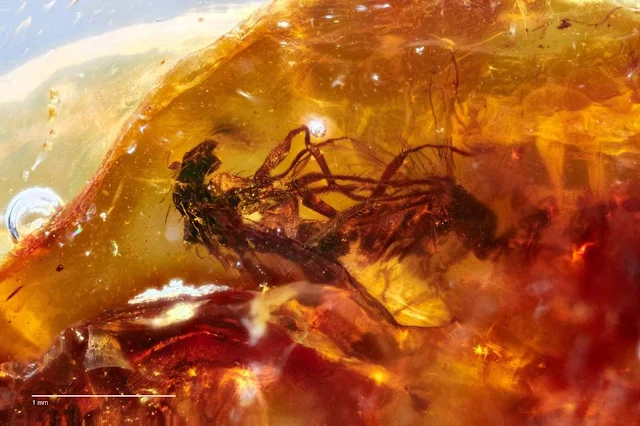Amber With Two Flies That Got Stuck Mating 40 Million Years Ago Discovered
 |
| Two mating, long-legged flies trapped in clear, honey-coloured amber, approximately 41 million years ago. (Photo: Jeffrey Stilwell) |
Paleontologists have unearthed a piece of amber containing two mating flies that were frozen in the act 40-42 million years ago.
The oldest known animals and plants preserved in amber from Southern Gondwana are reported in Scientific Reports this week. Gondwana, the supercontinent made up of South America, Africa, Madagascar, India, Antarctica and Australia, broke away from the Pangea supercontinent around 200 million years ago.
Jeffrey Stilwell and colleagues studied more than 5,800 amber pieces from the Macquarie Harbour Formation in Western Tasmania, dating back to the early Eocene Epoch (~54-52 million years ago) and Anglesea Coal Measures in Victoria, Australia, from the late middle Eocene (42-40 million years ago). The authors report a rare "frozen behaviour" of two mating long-legged flies (Dolichopodidae).
The specimens also include the oldest known fossil ants from Southern Gondwana and the first Australian fossils of 'slender springtails', a tiny, wingless hexapod. Other organisms preserved in the amber include a cluster of juvenile spiders, biting midges (Ceratopogonidae), two liverwort and two moss species.
The authors also studied deposits found at locations in southeastern Australia, Tasmania and New Zealand. These include the oldest reported amber from Southern Pangea dating back to 230 million years ago, 96-92 million year old deposits from forests near the South Pole and an intact fossil of an insect called a felt scale (Eriococcidae) from 54-52 million years ago.
 |
| Clear yellow amber containing a new, beautifully preserved biting midge from approximately 41 million years old. (Photo: Enrique Peñalver) |
To date, most amber records are from the Northern Hemisphere, so this discovery in southern Australia was enough to prompt a wider search.
Stilwell and his team began looking at sites across Australia and New Zealand, and their recently published results contain a remarkable abundance of amber from the ancient supercontinents of Southern Pangaea, which existed during the Triassic period, and Southern Gondwana, which existed from the Cretaceous to the Paleogene period and included South America, Africa, Madagascar, India, Antarctica, and Australia.
All in all, amongst the haul, the authors report more than 5,800 amber pieces, taken from Macquarie Harbour in western Tasmania - dating to around 54 million years ago - and also from Anglesea, Victoria - dating to around 42 million years ago.
The findings provide new insights into the ecology and evolution of Southern Gondwana and indicate that there may be a vast potential for future, similar finds in Australia and New Zealand.
The above story is based on materials provided by Monash University.

%20(1).webp)






